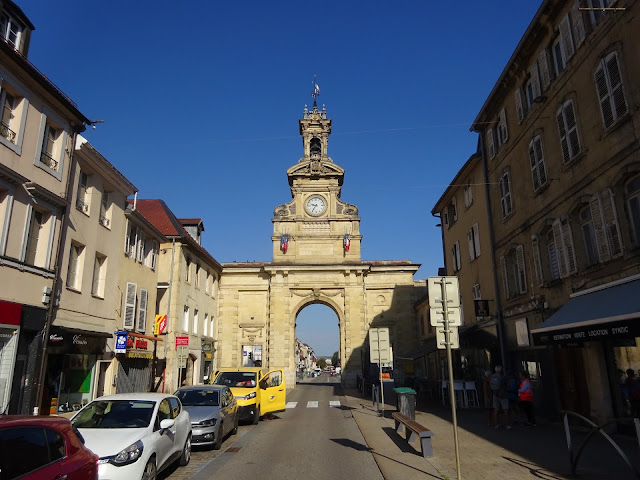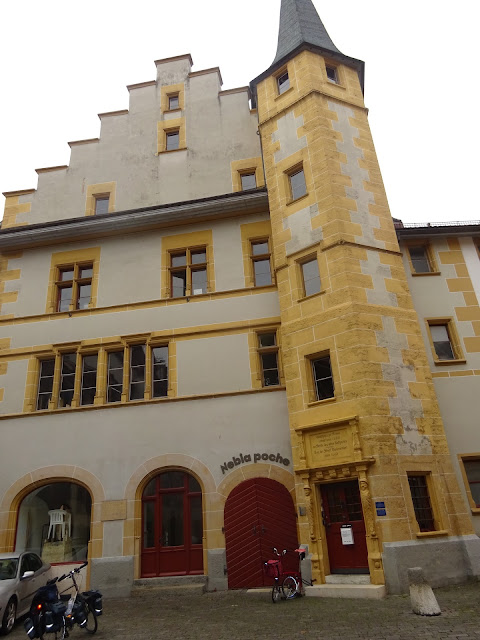Sunday, August 27, 2023
Fort de Joux (Pontarlier, France)
Nothing special about Pontarlier (population 20,000) though it does get to brag about being the second highest town in France. It gets pretty darn cold in the winter and the area is known as the Siberia of France.
I took this picture in Pontarlier for two reasons. The chapel up on the hill and the entrance to a large Nestle factory. Cycling past I could smell chocolate. It turns out this is where Nesquik is manufactured. Nesquik is chocolate syrup as well as chocolate powder you mix with milk.
Perched atop a steep and rocky hill about two miles from Pontarlier stands Fort de Joux. Since the 1400's this fortress has been guarding the narrow passage--an important trading route from Italy to the rest of Europe. Back in 1813 the Austrians attacked and after being besieged for 21 days the castle surrendered. Why? The Austrians revealed a serious weakness in the fort's defenses. See Fort Larmont higher up to the right on the other side of the narrow passageway? That wasn't there back in 1813 and the Austrians lugged artillery up there and proceeded to fire down on Fort de Joux.
Making my way up the road.
Here's the entrance.
The fortress had not one, not two but, three drawbridges. So, if one section gets breached then the soldiers fall back to the next drawbridge.
This casemate (a vaulted chamber which can resist bombardment) was built in 1881. The casemate is made of four cast iron plates--each plate is 10 inches thick and weighs 42 tons!
View from top with neighboring Fort Larmont in the distance.
Tourists going up to last set of steps leading to the prison cells which were located at the top of the fort. Around the time of the French Revolution and Napoleon's reign the fort was used as a prison. Fort de Joux was considered the boondocks of France and a miserable place to be in prison because of its isolation and cold. The fort's barracks could house between 500 to 600 soldiers.
This dizzying very narrow spiral staircase gives me the creeps. Built in 1879 and composed of 212 steps it's about the height of a 10-story building. Feels like it's going to collapse. It goes from the prison down to an underground tunnel. Also used to transport heavy items via a hoist in the middle of the stairs. Had to use the stairs to reach the water well.
The well was originally dug (through the rocks!) in 1690. At 482 feet deep (a football field is 360 feet long) it's reportedly the largest and deepest water well in Europe.
In 1879 underground tunnels were dug under the castle fortifications to connect opposite ends of the fortress.
Medics arrived to transport a young woman (don't know if she was ill, fell or victim of heat exhaustion) Ambulances can't get through the narrow openings so, it took eight firefighters/paramedics taking turns carrying the gurney.
Thursday, August 24, 2023
La Sarraz castle (La Sarraz, Switzerland)
Another view of Orbe river in Vallorbe.
I'm approaching La Sarraz (population 2,600) and here's a backside view of La Sarraz castle. The castle sits on a rocky outcrop overlooking a narrow passage. Built in 1049, it used its strategic position to make the castle owners immensely wealthy. How? Travelers passing through had to cough-up a tax/fee.
Front of La Sarraz castle. It was the residence of the barons of La Sarraz from 1049 until 1948. That's amazing for the same family to hold on to a property for such a long period of time. Now it's home to two museums.
Entrance.
Castle courtyard
Normally I don't post pictures of museum interiors but, gotta show you the portrait of Barbara. She's the woman to the left of the woman wearing the white gown. Barbara was married to Baron Joseph de Gingins back in 1583. So? She gave birth to an astonishing 17 children.
This barn dates back to 1725 and houses a horse museum.
Saturday, August 19, 2023
Biel/Bienne, Switzerland (old town) Blonay, Switzerland (steam train)
Back in the Middle Ages, erecting fancy elaborate fountains was a way to show off a town's wealth. Biel/Bienne still has several of these beauts still standing and they're great place for cyclists to fill-up their water bottles. This one I believe is blind justice.
See the woman with wings (angel?) holding on to the lamb for dear life? Why? See next photo for close-up.
Wow, that is one ugly-looking monster with breasts!
Street view.
Like the unusual color.
View of square.
Close-up of soldier, knight?
The village of Blonay lies high in the hills overlooking Lake Geneva. I was getting close to Blonay and saw plumes of smoke and thought something was on fire. Turns out it's this steam-powered train.
Weekends in the summer they give rides.
The track runs for three miles and connects to another track still in use for normal traffic. This steam engine (B.F.D.3) was built in 1913. At the end of the three miles there's a train museum featuring a slew of these beasts including many much older.
Cycling around a residential area near the train station in Blonay I find someone has set-up a miniature train line in their front yard.
Another view.
Friday, August 18, 2023
Bellelay Abbey (Bellelay, Switzerland)
I've been looking for an excuse to escape the summer heat and caught an article in the newspaper about Bellelay Abbey, a former monastery dating back to 1142 that is now a psychiatric clinic deep in the Jura Mountains. Much of the Jura Mountain range forms a natural border/barrier between Switzerland and France. Getting to isolated Bellelay Abbey involves going through multiple narrow valleys. It will be in the low 90's today but there's a slight reprieve heading down to the fogged-in town of Tavannes.
Tavannes (population 3,500) has no stoplights and on the main road through town I spot this former Tavannes Watch building. It's now apartments and it's connected to the building behind it. More than 20 years ago I spent two summers cycling around Switzerland visiting over 100 watch companies and writing about it. You can still read 'em on my www.corporatetrivia.com website.
Later in the evening I do a Google search and learn Tavannes Watch Company began in 1891. By 1938 Tavannes Watch had four factories, employeed over 3,000 people and was the fourth largest watch company in the world. In 1966 it went kaput.
The village of Bellelay lies ahead.What the heck, is that a bull in front of the white building?
In addition to the bull, the front of the white building also features two cows in serious combat. Closer inspection reveals the animals are made of hay.
I'm in front of the white building which says it's some kind of museum/store. They aren't open today. The vending machine sells Tete de Moine cheese. Never heard of the cheese but then again Switzerland has hundreds of brands and varieties. In 1142 monks at the monastery (Bellelay Abbey) were making this semi-hard cheese. In the 1970's cheese dairies in the region banded together and formed Tete de Moine AOP, a cheese cooperative, to market the cheeses.
So, here's the entrance to Bellelay Abbey.
Built in 1714, the main building is very impressive.
Another view from the side. Why is the place deserted? The newspaper article said the place was turned into a psychiatric clinic years ago.
I run into an attractive woman (I'd guess to be around 25 years old) walking the grounds with her dog, cat (yep, the cat is trailing along) and her two daughters on bikes (one looks to be around four and the other six years old). The woman says the psychiatric clinic closed down last year. This was a big blow to the village as it employeed 341 people. The Canton Bern owns the complex and had operated the clinic since 1890. In the USA we have states and in Switzerland they have cantons.
Though I enjoyed talking to the woman she had an off-putting feature--a nose ring. I don't understand why a woman would do that. Does she really think it's attractive? Doesn't snot come out of noses? She has no visible tattoos and as mentioned is quite attractive. I see cows and pigs with nose rings. Those of you who know me know I'm not very tactful and can be very blunt as I've been known to tell a stranger they have bad breath or stinky perfume. However, I bite my tongue and wonder if her daughters will copy mom and get nose rings later in life.
Another view of the former Bellelay Abbey complex. The place has quite a history. In 1772 it was a monastery university housing more than 100 students from throughout Europe. In the 19th century the premises were used as a watch factory, then as a brewery and finally as a glass factory before becoming a psychiatric clinic in 1890.Several apartment buildings lie within the walled complex.This looks to be one heck of a large chapel. Can't get in is as it's closed.
Heading back through Tavannes the fog has lifted.















































